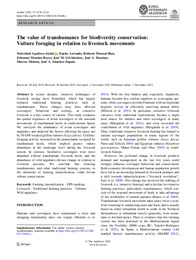Please use this identifier to cite or link to this item:
https://hdl.handle.net/11000/33917Full metadata record
| DC Field | Value | Language |
|---|---|---|
| dc.contributor.author | Aguilera-Alcalá, Natividad | - |
| dc.contributor.author | Arrondo, Eneko | - |
| dc.contributor.author | Pascual-Rico, Roberto | - |
| dc.contributor.author | Morales-Reyes, Zebensui | - |
| dc.contributor.author | Gil-Sánchez, José M. | - |
| dc.contributor.author | Donázar, José Antonio | - |
| dc.contributor.author | Moleón, Marcos | - |
| dc.contributor.author | Sánchez-Zapata, Jose´ A. | - |
| dc.contributor.other | Departamentos de la UMH::Biología Aplicada | es_ES |
| dc.date.accessioned | 2024-11-19T09:44:01Z | - |
| dc.date.available | 2024-11-19T09:44:01Z | - |
| dc.date.created | 2021-12-07 | - |
| dc.identifier.citation | Ambio 2022, 51:1330–1342 | es_ES |
| dc.identifier.issn | 1654-7209 | - |
| dc.identifier.issn | 0044-7447 | - |
| dc.identifier.uri | https://hdl.handle.net/11000/33917 | - |
| dc.description.abstract | In recent decades, intensive techniques of livestock raising have flourished, which has largely replaced traditional farming practices such as transhumance. These changes may have affected scavengers’ behaviour and ecology, as extensive livestock is a key source of carrion. This study evaluates the spatial responses of avian scavengers to the seasonal movements of transhumant herds in south-eastern Spain. We surveyed the abundance of avian scavengers and ungulates, and analysed the factors affecting the space use by 30 GPS-tracked griffon vultures (Gyps fulvus). Griffons’ foraging activity increased in the pasturelands occupied by transhumant herds, which implied greater vulture abundance at the landscape level during the livestock season. In contrast, facultative scavengers were more abundant without transhumant livestock herds, and the abundance of wild ungulates did not change in relation to livestock presence. We conclude that fostering transhumance and other traditional farming systems, to the detriment of farming intensification, could favour vulture conservation. | es_ES |
| dc.format | application/pdf | es_ES |
| dc.format.extent | 13 | es_ES |
| dc.language.iso | eng | es_ES |
| dc.publisher | Springer | es_ES |
| dc.rights | info:eu-repo/semantics/openAccess | es_ES |
| dc.rights.uri | http://creativecommons.org/licenses/by-nc-nd/4.0/ | * |
| dc.subject | Farming intensification | es_ES |
| dc.subject | GPS-tracking | es_ES |
| dc.subject | Livestock | es_ES |
| dc.subject | Traditional farming practices | es_ES |
| dc.subject | Vultures | es_ES |
| dc.subject | Wild ungulates | es_ES |
| dc.subject.other | CDU::5 - Ciencias puras y naturales::57 - Biología | es_ES |
| dc.title | The value of transhumance for biodiversity conservation: Vulture foraging in relation to livestock movements | es_ES |
| dc.type | info:eu-repo/semantics/article | es_ES |
| dc.relation.publisherversion | https://doi.org/10.1007/s13280- 021-01668-x | es_ES |

View/Open:
33.pdf
1,03 MB
Adobe PDF
Share:
.png)
